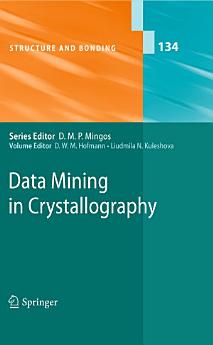Data Mining in Crystallography
D. W. M. Hofmann · Liudmila N. Kuleshova
dec. de 2009 · Structure and Bonding Libro 134 · Springer
Libro electrónico
172
Páxinas
reportAs valoracións e as recensións non están verificadas Máis información
Acerca deste libro electrónico
Humans have been “manually” extracting patterns from data for centuries, but the increasing volume of data in modern times has called for more automatic approaches. Early methods of identifying patterns in data include Bayes’ theorem (1700s) and Regression analysis (1800s). The proliferation, ubiquity and incre- ing power of computer technology has increased data collection and storage. As data sets have grown in size and complexity, direct hands-on data analysis has - creasingly been augmented with indirect, automatic data processing. Data mining has been developed as the tool for extracting hidden patterns from data, by using computing power and applying new techniques and methodologies for knowledge discovery. This has been aided by other discoveries in computer science, such as Neural networks, Clustering, Genetic algorithms (1950s), Decision trees (1960s) and Support vector machines (1980s). Data mining commonlyinvolves four classes of tasks: • Classi cation: Arranges the data into prede ned groups. For example, an e-mail program might attempt to classify an e-mail as legitimate or spam. Common algorithmsinclude Nearest neighbor,Naive Bayes classi er and Neural network. • Clustering: Is like classi cation but the groups are not prede ned, so the algorithm will try to group similar items together. • Regression: Attempts to nd a function which models the data with the least error. A common method is to use Genetic Programming. • Association rule learning: Searches for relationships between variables. For example, a supermarket might gather data of what each customer buys.
Valora este libro electrónico
Dános a túa opinión.
Información de lectura
Smartphones e tabletas
Instala a aplicación Google Play Libros para Android e iPad/iPhone. Sincronízase automaticamente coa túa conta e permíteche ler contido en liña ou sen conexión desde calquera lugar.
Portátiles e ordenadores de escritorio
Podes escoitar os audiolibros comprados en Google Play a través do navegador web do ordenador.
Lectores de libros electrónicos e outros dispositivos
Para ler contido en dispositivos de tinta electrónica, como os lectores de libros electrónicos Kobo, é necesario descargar un ficheiro e transferilo ao dispositivo. Sigue as instrucións detalladas do Centro de Axuda para transferir ficheiros a lectores electrónicos admitidos.







